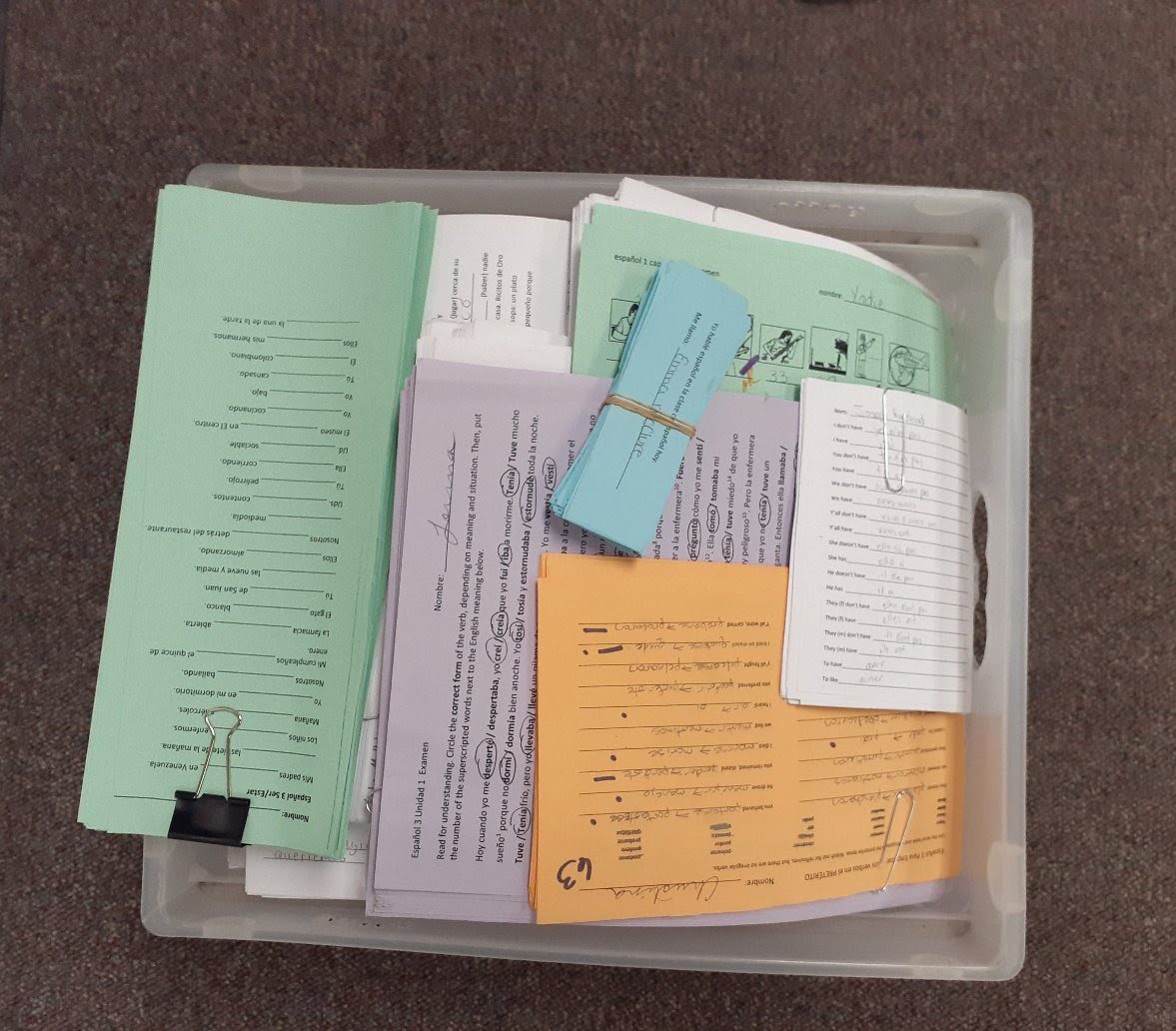HELP!! I don’t know what color the top of my desk is!
At the beginning of every new year, people make resolutions that “this is the year that I’m going to get organized!” A whole industry has been built on those resolutions, and many of the solutions to a cluttered life can be very expensive.
As one of the cheapest teachers alive, I have found that organization does not have to be complicated or expensive. The mainstays of my system are paperclips, a small plastic drawer system (depending on how many classes I have, usually 3 for my block classes), a crate (or 2), a few three-inch notebooks, and an in-box for my desk.
Keep in mind that I teach high school. Middle school teachers can also use this system. Elementary teachers will likely need to modify a bit, since your system would be based more on subject matter, rather than changing classes.
Making Copies
Every morning when I go to print the copies that I will need for the day, I make just enough for my students. I don’t many ANY EXTRAS!! Just like when you make too much food for a party, you are just going to throw those extra copies away! They will only cause clutter in your life.
Anything that I can print double-sided, I do. Anything that I can shrink to half-sheets (kids have amazing young eyes!), I combine with another half-sheet to conserve paper. It was a habit formed during the recession years of 2008-2010 when we were rationed on paper, and I have found it to also be helpful in reducing clutter.
Then I paper-clip each set of papers and stack them on my desk in the chronological order that I am going to hand them out throughout the day. I make sure all my students will be able to finish the assignments within in the class period. As a veteran teacher, I have a pretty good idea of how much time will be needed for each activity.
Get to Work . . .
When I hand out the activity and watch the students complete it, I insist that they turn it in by the end of the class period. This goes for EVERYONE. Even if I underestimate the time necessary to complete an activity, I still insist that everyone turn it in at the end of the class. This accomplishes 3 things:
- students quickly learn that they will not be allowed to play around in class!
- The students won’t lose the paper from one day to the next.
- I can see how much progress they are making. Especially at the beginning of the semester when I don’t know them well, I can glance through their work to see who finished quickly and who didn’t. Or who knows what they are doing and who doesn’t.
While the students are working (usually in pairs or groups!), I write the names of absent students on their copy of the activity (remember- I have exactly enough!). When the rest of the student turn in their work, I put the absent student’s paper in the same stack with all the rest of the class’s papers.
Students can either turn their work into the inbox on my desk if they finish before the end of class. Or I walk around the room, collecting them, ready or not. Sometimes I stand at the door and snatch them right out of their hands as they are leaving!
So then what? I grab all the papers out of the inbox and paperclip them together, stick them in the drawer for that class period, and start the process over for the next class. At the end of a normal day, I will have an activity or two in each class’s drawer.
Time to Grade!
I take out a paper-clipped set of papers, grade it, enter the grade in my system, and put the paper clip back on. I take the paper-clipped set of papers and dump it into a crate. They are now out of sight, out of mind, but easily accessible.
I don’t give students their regular classwork back after grading. If it’s a quiz or a test, I pass out the paper, allow them to ask questions, and they they have to hand it back in. (I threaten that if I don’t get it back I will give them a 0!) I have reasons for not letting students keep their papers:
- I’m lazy and I re-use (but modify) my activities from semester to semester. I don’t need the students selling the answers for my activities on the student black market (yes, it exists!).
- I walk around so much during the activities, that I have usually already given them verbal feedback on their work, and they don’t need to see a grade.
- Most of my activities are partner collaborations, so I grade on completion only anyway.
- If students get a classwork activity back, it’s because the whole class is going to do error correction and then turn it back in anyway.
- They are just going to make a bonfire out of their school papers at the end of the semester anyway, and I don’t want to give them the satisfaction of such high flames!
Record Keeping
Now in my crate I have a record of my students’ work for the whole semester. If a parent, counselor, or administrator wants to see a student’s work, I have the evidence. I can go to specific activities, and pull that student’s work out of the paperclip. It doesn’t happen often, though.
What is more common is a student accuses me of losing things. When that happens, I pull out the whole paper-clipped stack of the activity in question, show the student that for some reason, I have papers from EVERYONE except for him. Usually we do a back-pack intervention at that point, and somehow we almost always find the wayward paper stuffed at the bottom of the backpack (where it was not supposed to be anyway, because I always take everything up!).
Sometimes a student might question a grade, because yes, I make mistakes, and enter grades incorrectly into the system sometimes. Then I have the work and can easily compare to make sure my entry was correct.
But what about the Master Copies?
Here is a seemingly small, but important part of the organization process: I have a small bin (to be honest, it’s the upside-down lid of one of our paper boxes- not anything fancy!) where I put my master copies. When I come back from the copy machine in the morning, I put the actual copies on my desk, and the master copy FACE UP in the master-copy bin. Every day throughout the semester, I add to the stack. Everything goes in the stack, no matter how many different preps I have: French 1, Spanish 3, doesn’t matter.
At the end of the semester during post-planning or (pre-planning of the next semester, depending on my energy levels!), I pull out the master-copy bin. Remember that the last copies are at the top of my stack because everything was FACE UP! I take 5 minutes and sort all the copies into the different preps that I had, again, FACE UP.
When I finish sorting, I should have a stack of French 1 and a stack of Spanish 3. The syllabus should be the first item on the top of each stack, and the final exam should be at the bottom of the stack. I hole-punch, and make a binder for each prep, and then I have a whole course of master copies in a nice binder in chronological order ready for me to access the next year for ideas, or to share with new teachers who might need a helping hand!
And then what?
The last, most important question you might have is, “What should I do with the crate (or 2!) at the end of the semester?” Typically, I keep the student work for a month after the semester ends in case there is a question about a final grade. And then I THROW THE WORK AWAY!!!! Let it go. You don’t need it. If it makes you feel better, make a bonfire with it, just like the students do! The papers are just consumables in the process of teaching and learning. If there are a few STELLAR examples of student work, keep them if you would like to make a portfolio of those items, but the rest can be recycled.
Keeping stuff that you don’t need is what is holding you back from being organized. And the longer you put it off, the worse it gets! So go tackle that mess now, and make this year the one where you achieve that New Year’s Resolution!



